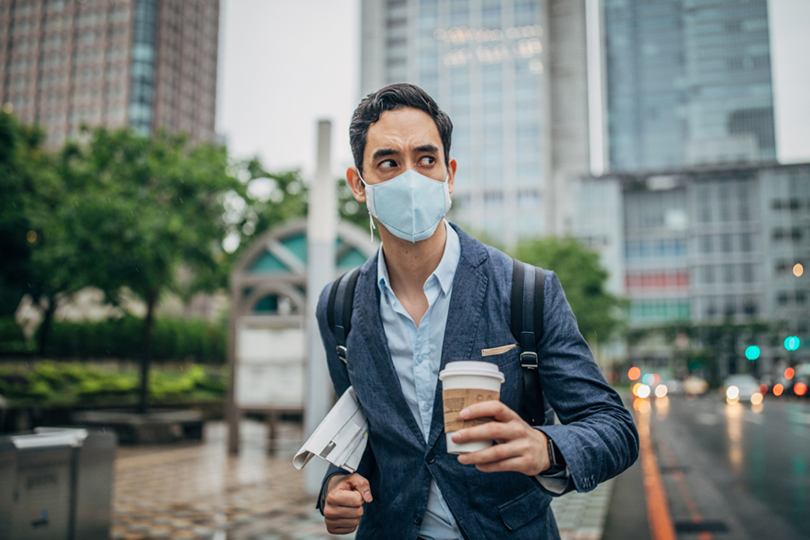If you think about it, “the face mask is the condom of our generation,” says Brian Castrucci, the president of the de Beaumont Foundation, a public-health nonprofit. Castrucci spent a decade working in state and local health departments, and he remembers when the HIV epidemic made condoms mainstream in the United States. No one was especially thrilled about it, but as the dangers of unprotected sex became clear, people came to accept them.
The same can now be said of face masks, which have gone from seeming like a silly overreaction to a ubiquitous pandemic necessity. Parents are pulling them onto their toddlers. Waiters are wearing them. Pool-goers might don them. There’s even a disturbing-looking contraption that lets you eat with one on.
We’ll probably keep having to wear masks in public for the foreseeable future. Ben Cowling, the head of epidemiology at the University of Hong Kong’s School of Public Health, told me he recommends wearing masks on public transit or in crowded areas even after it’s safe to leave our homes again. Trish Greenhalgh, a primary-care professor at the University of Oxford, told me people should wear masks in public until “there are no new cases, or very few cases,” a goal that the U.S. is still very far from reaching.
But while masks are good for public health, they also make our interactions more difficult by concealing the lower part of our face. The constant social ambiguity might get harder to take once states start opening up more fully, and we resume some of our regular activities. Some experts say that might portend a push toward different types of coverings that don’t hide our face. Or, it might mean that our norms of communication will change, perhaps forever.
David Matsumoto, a psychologist who runs a body-language-training company called Humintell, told me that we might be losing a lot of context if we’re communicating with only our eyes, especially from six feet away. “A lot of the visual cues that you see in normal interaction is that large part of the face from the bridge of the nose down,” Matsumoto said. Without these cues, there’s a much greater chance of misunderstanding. Whether you’re being genuine or sarcastic, for instance, stems from the shape of your mouth when you say it. Even the most expert “smizer” has probably worried that they look mad with a mask on. It’s also harder to develop and maintain social bonds when you’re not talking with your full face. “That’s why we have ‘face-to-face interactions’ and not ‘knee-to-knee interactions,’” Matsumoto said.
If people get fed up with masks, one option might be to use face shields: clear-plastic guards attached to a headband. These at least allow you to see your interlocutor’s face, and for the hearing impaired, they allow for lip-reading. For people working in jobs that require a face covering, face shields might simply be more pleasant to wear all day. “I can imagine that if you were bagging groceries six hours a day that it would be probably much more comfortable to wear a face shield,” says Angela Rasmussen, a virologist at Columbia University.
No studies have yet compared whether masks or face shields are more effective at preventing coronavirus transmission, but it’s possible that shields might keep us safer. Michael Edmond, a University of Iowa epidemiologist, has written that face shields reduce exposure to more than 90 percent of flu droplets from a cough, and unlike masks, they have the added benefit of keeping viral droplets out of a person’s eyes. People wearing masks might also be tempted to scratch or touch their face, but people wearing shields physically can’t.
Yet Cowling said he doesn’t think a face shield would be as effective as a mask for this pandemic. While a shield could protect the wearer from large droplets, he said, it wouldn’t prevent them from spewing the virus. (Edmond points out that a cloth mask does not perfectly keep in droplets, either.)
Then there is face shields’ distinctive look. They are, well, dorky. Edmond says many of the staffers at the hospital where he works wear face shields, and they’ve gotten used to walking around looking like Lego welders. But regular people might not be ready.
Even though they make social interactions more challenging, masks might continue to be more common than face shields simply because they can be made at home without any special supplies. If that’s the case, it might be necessary to change the way we communicate in order to convey what we mean without using facial expressions. The small smirks and grimaces we rely on to get the real point across might soon go the way of the bow or curtsy.
To overcome these hurdles, Matsumoto recommends people gesture more—and really just say more—when they’re wearing masks. People should ask one another more questions and confirm one another’s understanding: I’m hearing you say this; am I understanding that right? It’s important to not assume someone will know what you mean.
Perhaps these tricks will even help us communicate more clearly long after we can finally take our masks off. If not, there are always emoji hats.







Comments